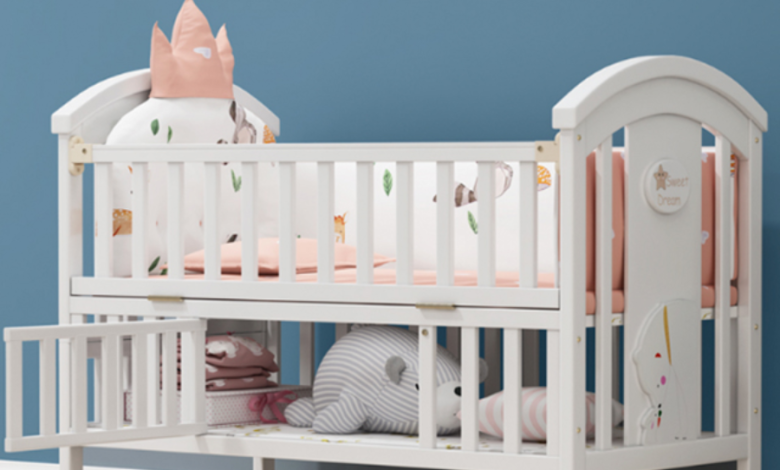A Deep Dive into the World of Baby Cots: Types and Features
Baby Cots

Designing a cozy and safe sleeping space for your baby is a significant aspect of creating a nurturing nursery environment. A baby cot, also known as a crib, serves as the focal point of this space, providing a secure and comfortable place for your little one to rest and sleep. In this comprehensive guide, we’ll take a deep dive into the world of baby cots, exploring the various types, essential features, safety considerations, and tips for choosing the perfect cot for your baby’s nursery.
Understanding the Importance of Baby Cots:
1. Safety and Security:
Baby cots are designed with high sides and secure railings to create a safe and enclosed sleeping environment for infants. This helps prevent accidental falls and ensures that the baby stays protected while sleeping.
2. Promoting Quality Sleep:
Quality sleep is crucial for a baby’s growth and development. A well-designed cot provides a comfortable and supportive mattress, promoting a restful sleep environment for your little one.
3. Long-Term Use:
Many baby cots are designed to be adjustable and convertible, accommodating the changing needs of your child as they grow. This makes the cot a long-term investment that can be used from infancy to toddlerhood and beyond.
4. Nursery Aesthetics:
Baby cots contribute significantly to the overall aesthetics of the nursery. With various styles and designs available, a well-chosen cot can enhance the visual appeal of the nursery space.
Types of Baby Cots:
1. Standard or Single Drop-Side Cots:
Standard cots have fixed sides with the option of a single drop side that can be lowered for easy access to the baby. However, drop-side cots have become less common due to safety concerns, as they were associated with incidents of entrapment.
2. Convertible or 4-in-1 Cots:
Convertible cots are designed to adapt to the changing needs of your child. They can be converted into different configurations, such as a toddler bed, daybed, or even a full-sized bed. This versatility extends the use of the cot as your child grows.
3. Sleigh Cots:
Sleigh cots feature a distinctive design with curved or scrolled headboards and footboards, resembling a sleigh. This style adds an elegant and classic touch to the nursery, making it a popular choice for parents who prioritize aesthetics.
4. Round Cots:
Round cots deviate from the traditional rectangular shape and feature a circular design. These unique cots provide a cozy and intimate sleeping space for the baby, and their unconventional shape can be a statement piece in the nursery.
5. Portable Travel Cots:
Travel cots are designed for portability, making them convenient for families on the go. These cots are lightweight, foldable, and often come with a carrying bag, making them suitable for travel or temporary use.
6. Cot Beds:
Cot beds are larger than standard cots and can convert into toddler beds. They provide an extended lifespan for the furniture, accommodating your child’s growth into the toddler years. Cot beds often have adjustable mattress heights to cater to different developmental stages.
7. Compact or Space-Saving Cots:
Compact cots are designed for smaller nursery spaces. They maintain the essential features of a standard cot but with a more space-efficient footprint, making them suitable for apartments or rooms with limited space.
Essential Features to Consider:
1. Adjustable Mattress Heights:
Many cots come with adjustable mattress heights to accommodate your baby’s growth. Starting with a higher mattress position for a newborn and lowering it as the baby becomes more mobile ensures a safe and secure sleeping environment.
2. Teething Rails:
Teething rails are protective covers along the edges of the cot to prevent the baby from gnawing on the wood. These rails not only protect the cot but also provide relief for teething infants.
3. Convertible Design:
A convertible cot offers versatility, allowing it to be transformed into different configurations as your child grows. This feature extends the usefulness of the cot and provides long-term value.
4. Quality of Materials:
Pay attention to the quality of materials used in the construction of the cot. Choose a cot made from sturdy and non-toxic materials, ensuring the safety and well-being of your baby.
5. Safety Standards Compliance:
Ensure that the cot meets safety standards and regulations. Look for certification labels or statements from the manufacturer confirming compliance with safety guidelines.
6. Proper Ventilation:
Adequate ventilation is essential for a comfortable sleep environment. Opt for cots with slatted sides to promote air circulation, preventing the baby from overheating during sleep.
7. Ease of Assembly and Disassembly:
Consider the ease of assembly and disassembly, especially for portable or travel cots. Quick and straightforward assembly is valuable, particularly when setting up the cot in a new environment.
8. Storage Options:
Some cots come with built-in storage options, such as drawers or shelves underneath. This added storage can be convenient for keeping baby essentials within easy reach.
9. Cot Mattress Quality:
The quality of the cot mattress is as crucial as the cot itself. Invest in a firm and breathable mattress that fits the cot snugly. Ensure that the mattress meets safety standards for infant sleep.
Safety Considerations for Baby Cots:
1. Avoid Soft Bedding:
Remove soft bedding items such as pillows, bumper pads, and soft toys from the cot. These can pose a suffocation risk for the baby.
2. Position the Baby on Their Back:
Always place your baby on their back to sleep. This sleeping position has been shown to reduce the risk of SIDS.
3. Ensure Proper Ventilation:
Avoid placing heavy or obstructive items around the cot that may limit airflow. Proper ventilation is crucial for your baby’s safety during sleep.
4. Check for Recalls:
Stay informed about any recalls related to the cot model you choose. Register your cot with the manufacturer to receive notifications about safety recalls promptly.
5. Regularly Inspect the Cot:
Periodically inspect the cot for any signs of wear, damage, or loose parts. Ensure that all hardware is tightened securely, and there are no sharp edges that could harm the baby.
6. Follow Assembly Instructions:
Strictly follow the manufacturer’s assembly instructions to ensure the cot is set up correctly. Incorrect assembly may compromise the safety of the cot.
7. Ensure Rails Are Secure:
Regularly check that the cot rails are secure, and there are no gaps or spaces where the baby’s limbs could become trapped.
Choosing the Perfect Cot for Your Baby:
1. Consider Nursery Space:
Assess the available space in your nursery before choosing a cot. This ensures that the cot fits comfortably and allows for other essential furniture and accessories.
2. Evaluate Your Style Preferences:
Choose a cot that aligns with your style preferences and the overall theme of the nursery. Whether you prefer a classic sleigh design or a more modern and minimalist look, there are cots available to suit various aesthetics.
3. Prioritize Safety Features:
Look for features such as adjustable mattress heights, teething rails, and compliance with safety standards to ensure a secure sleeping space for your baby.
4. Think Long-Term:
If you want a cot that grows with your child, consider investing in a convertible cot or cot bed. This provides extended usability and eliminates the need for transitioning to a toddler bed later on.
5. Read Reviews and Recommendations:
Read reviews from other parents and seek recommendations from friends or family who have experience with specific cot models. Real-life experiences can provide valuable insights into the durability and functionality of different cots.
6. Check for Certification:
Ensure that the cot meets safety standards by checking for certification labels or statements from the manufacturer. This confirms that the cot has undergone testing for safety and compliance.
7. Assess Adjustable Features:
Consider the adjustable features of the cot, such as mattress heights. Adjustable features allow you to customize the cot to meet the specific needs of your growing baby.
8. Budget Considerations:
Establish a budget for the cot, considering both the initial purchase and long-term value. While quality is essential, there are cots available at various price points to accommodate different budgets.
Conclusion
Selecting the perfect baby cots for your baby involves a thoughtful consideration of safety features, design preferences, and long-term usability. From classic sleigh cots to space-saving designs and convertible options, the world of baby cots offers a diverse range of choices to cater to different needs and preferences. By prioritizing safety, evaluating features, and considering the aesthetics of your nursery furniture, you can create a comfortable and secure sleeping space for your little one, contributing to their overall well-being and development.




